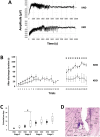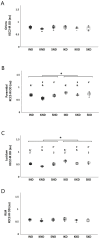Effects of the ketogenic diet on dentate gyrus and CA3 KCC2 expression in male rats with electrical amygdala kindling-induced seizures
- PMID: 40264914
- PMCID: PMC12011780
- DOI: 10.3389/fnins.2025.1489407
Effects of the ketogenic diet on dentate gyrus and CA3 KCC2 expression in male rats with electrical amygdala kindling-induced seizures
Abstract
Introduction: Ketogenic diet (KD), a high-fat, low-carbohydrate, and adequate protein diet, is a non-pharmacological treatment for refractory epilepsy. However, their mechanism of action is not fully understood. The cation-chloride cotransporter, KCC2, transports chloride out of neurons, thus contributing to the intraneuronal concentration of chloride. Modifications in KCC2 expression by KD feeding could explain the beneficial effect of this diet on epilepsy. This study aimed to determine the impact of KD on KCC2 expression in dentate gyrus layers and Cornu Ammonis 3 (CA3) strata of rats with seizures induced by amygdaloid kindling.
Materials and methods: Male Sprague Dawley rats were fed a normal diet (ND) or KD from postnatal day 24 until the end of the experiment. At 6 weeks after the start of the diets, rats were subjected to an amygdala kindling epilepsy model, sham or remain intact. Glucose and β-hydroxybutyrate concentrations were quantified. The after-discharge duration (ADD), latency, and duration of stages of kindling were evaluated. In addition, KCC2 expression was evaluated using optical density. A Pearson bivariate correlation was used to determine the relationship between KCC2 expression and ADD.
Results: At the end of the experiment, the KD-fed groups showed a reduction in glucose and an increase in β-hydroxybutyrate. KD reduced ADD and increased latency and duration of generalized seizures. In ND-fed animals, kindling reduced KCC2 expression in all three layers of the dentate gyrus; however, in KD-fed animals, no changes were observed. KD treatment increased KCC2 expression in the kindling group. In CA3, the pyramidal and lucidum strata showed an increase of KCC2 in KD-fed groups. Besides, the kindling had lower levels of KCC2 than the sham and intact groups. In all layers of the dentate gyrus and pyramidal and lucidum CA3 strata, the correlation indicated that the higher the KCC2 expression, the shorter the ADD during generalized seizures.
Conclusion: KD reduces ADD in generalized seizures. In addition, KD has a putative neuroprotective effect by preventing the kindling-induced reduction of KCC2 expression in the molecular, granule, and hilar dentate gyrus layers and pyramidal and lucidum CA3 strata. Increased KCC2 expression levels are related to a shorter duration of generalized seizures.
Keywords: CA3; KCC2; dentate gyrus; ketogenic diet; kindling; rat.
Copyright © 2025 Granados-Rojas, Hernández-López, Bahena-Alvarez, Juárez-Zepeda, Custodio, Martínez-Galindo, Jerónimo-Cruz, Tapia-Rodríguez, Vanoye-Carlo, Duran and Rubio.
Conflict of interest statement
The authors declare that the research was conducted in the absence of any commercial or financial relationships that could be construed as a potential conflict of interest.
Figures





Similar articles
-
Ketogenic diet protects against epileptogenesis as well as neuronal loss in amygdaloid-kindling seizures.Neurosci Lett. 2012 Feb 2;508(1):22-6. doi: 10.1016/j.neulet.2011.12.002. Epub 2011 Dec 13. Neurosci Lett. 2012. PMID: 22178860
-
Ketogenic Diet Provided During Three Months Increases KCC2 Expression but Not NKCC1 in the Rat Dentate Gyrus.Front Neurosci. 2020 Jul 7;14:673. doi: 10.3389/fnins.2020.00673. eCollection 2020. Front Neurosci. 2020. PMID: 32733191 Free PMC article.
-
Effectiveness of ketogenic diet in pentylenetetrazol-induced and kindling rats as well as its potential mechanisms.Neurosci Lett. 2016 Feb 12;614:1-6. doi: 10.1016/j.neulet.2015.12.058. Epub 2016 Jan 2. Neurosci Lett. 2016. PMID: 26751594
-
[Effect of ketogenic diet on hippocampus synaptic reorganization and GluR5 expression in kainic acid induced rat model of epilepsy].Zhonghua Er Ke Za Zhi. 2006 Feb;44(2):100-4. Zhonghua Er Ke Za Zhi. 2006. PMID: 16624024 Chinese.
-
The role of the piriform cortex in kindling.Prog Neurobiol. 1996 Dec;50(5-6):427-81. doi: 10.1016/s0301-0082(96)00036-6. Prog Neurobiol. 1996. PMID: 9015822 Review.
References
-
- Aronica E., Boer K., Redeker S., Spliet W. G. M., van Rijen P. C., Troost D., et al. . (2007). Differential expression patterns of chloride transporters, Na+-K+-2Cl−-cotransporter and K+-cl−-cotransporter, in epilepsy-associated malformations of cortical development. Neuroscience 145, 185–196. doi: 10.1016/j.neuroscience.2006.11.041, PMID: - DOI - PubMed
LinkOut - more resources
Full Text Sources
Miscellaneous

